Bloomberg
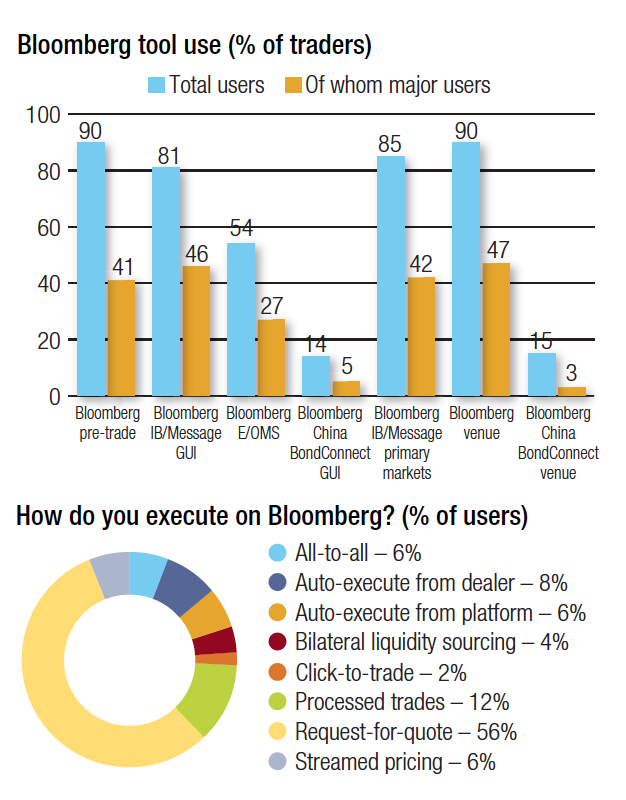 Bloomberg has the highest penetration of any provider into the buy-side fixed income trading desk. This year has seen it significantly revise charges to sell-side firms for trading in debt markets which it has billed as a way of raising revenues for investing into new services. This has accelerated its ability to offer new services but potentially reduced the attractiveness of use over the shorter term.
Bloomberg has the highest penetration of any provider into the buy-side fixed income trading desk. This year has seen it significantly revise charges to sell-side firms for trading in debt markets which it has billed as a way of raising revenues for investing into new services. This has accelerated its ability to offer new services but potentially reduced the attractiveness of use over the shorter term.
While a broad range of trading protocols are used on the platform, it has not managed to match the all-to-all offerings of rivals like MarketAxess, Liquidnet or Tradeweb.
The use of unstructured IB Chat / messaging in fixed income trading still supports it against more structured trading GUIs, and while Symphony continues to grow its share does not yet amount to a significant threat. In the EMS/OMS space Bloomberg is also beating rivals hands down.
DirectBooks
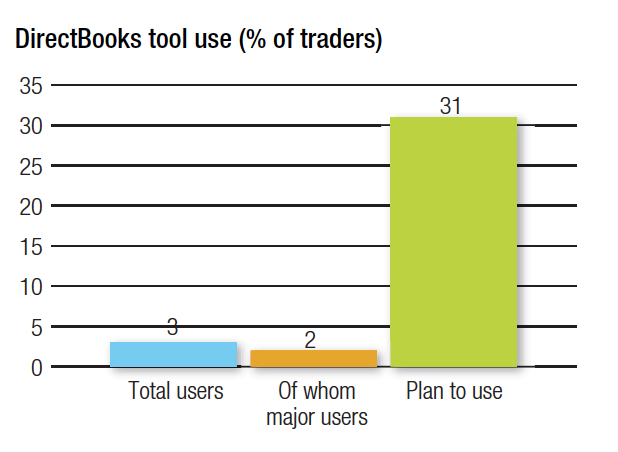 A newcomer into the primary market space built by a consortium of US dealers, DirectBooks has the largest pipeline of traders planning to use it for any primary markets platform. “All eyes on DirectBooks” as one respondent noted.
A newcomer into the primary market space built by a consortium of US dealers, DirectBooks has the largest pipeline of traders planning to use it for any primary markets platform. “All eyes on DirectBooks” as one respondent noted.
While there is a very keen appetite for improving the primary market new issue process, by standardising the data provided by sell-side firms and removing the replication of information by the sell-side, it has been noted that with its launch at the end of 2020 DirectBooks missed the biggest year on record for newly issued bonds, which would have made it a shoe-in for asset managers, still lacks engagement from many dealers, and has not yet fully rolled out functionality to overcome all of the buy side’s problems with managing sell side activity.
Yet the backing of the major investment banks is widely expected to give DirectBooks the momentum needed to continue to grow, which it is expected will allow it to develop more effective primary market processes than exist today.
IHS Markit
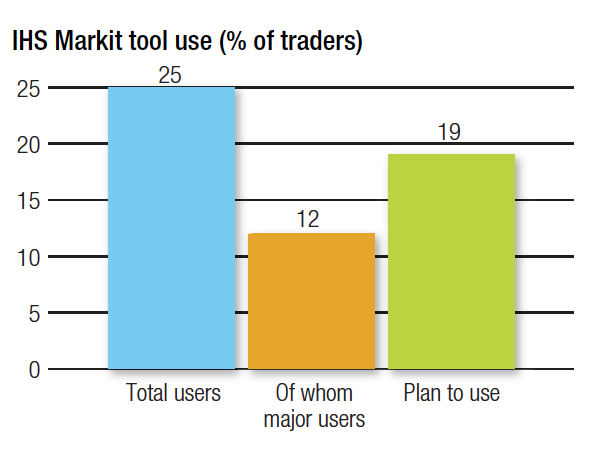 The most established primary market platform, IHS Markit’s suite of tools (formerly known as Ipreo) has a 25% foothold amongst buy-side firms already, with many of them using the platform heavily.
The most established primary market platform, IHS Markit’s suite of tools (formerly known as Ipreo) has a 25% foothold amongst buy-side firms already, with many of them using the platform heavily.
The acquisition of Ipreo by IHS Markit in 2018 framed it within a larger organisation built on data and services, and the ongoing merger between IHS Markit and S&P will further expand the ecosystem around this set of tools.
It is seriously challenged in the US, where the consortium of dealers that have formed DirectBooks have reportedly snubbed connecting with IHS Markit’s platform. Nevertheless, with 19% of traders still planning to use it has the potential to win the lion’s share of business.
MarketAxess
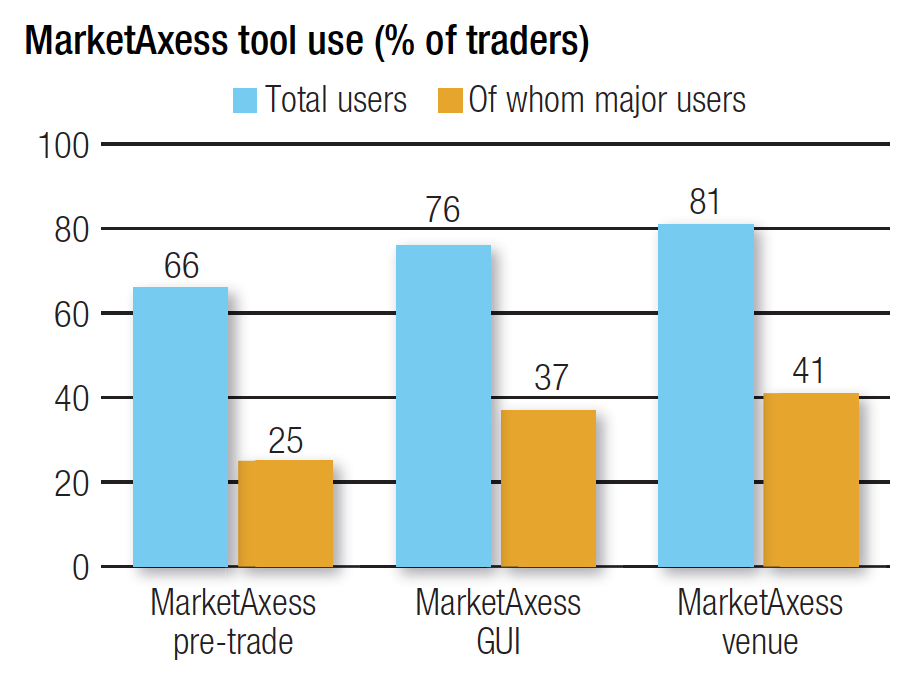 Consistently rated as the most effective platform for finding liquidity in the corporate bond market, MarketAxess has frequently been ahead of the market in terms of its data offerings and trading protocols.
Consistently rated as the most effective platform for finding liquidity in the corporate bond market, MarketAxess has frequently been ahead of the market in terms of its data offerings and trading protocols.
“Our innovation agenda has ensured that we continue to be disruptive in a positive sense, pushing boundaries so that clients are confident in having our support into the future,” says Gareth Coltman, global head of trading automation at MarketAxess.
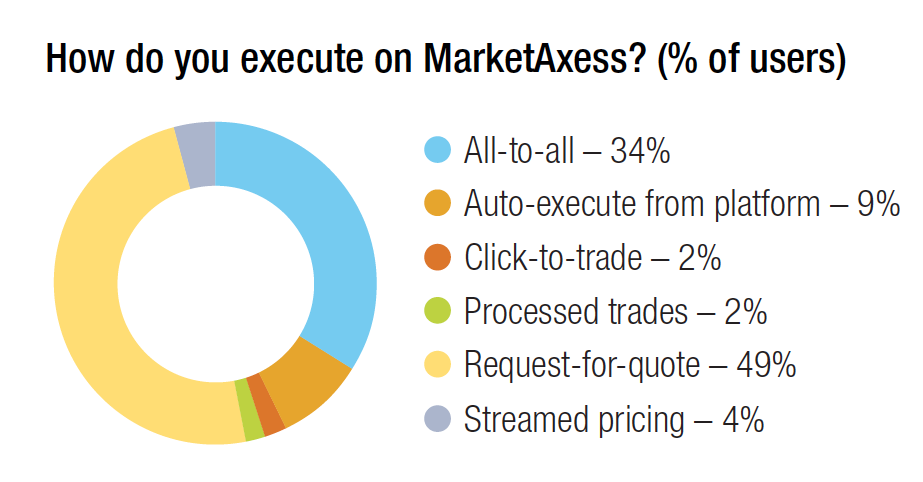 In 2020 the firm’s all-to-all trading protocol Open Trading was its key differentiator and since the sell-off in March 2020 it has continued to boom as a way of finding liquidity. As a pre-trade source CP+, MarketAxess’ composite pricing tool, has also seen great success with some growth in use to reach 66% of traders this year and a full 25% of traders reporting themselves as major users of it as a tool. It has also succeeded in delivering innovation in combination with other protocols.
In 2020 the firm’s all-to-all trading protocol Open Trading was its key differentiator and since the sell-off in March 2020 it has continued to boom as a way of finding liquidity. As a pre-trade source CP+, MarketAxess’ composite pricing tool, has also seen great success with some growth in use to reach 66% of traders this year and a full 25% of traders reporting themselves as major users of it as a tool. It has also succeeded in delivering innovation in combination with other protocols.
“In addition to Open Trading and the positive results we have seen from that over the past year, we have sought to look at how clients can find liquidity in our existing markets and how we can expand into new markets,” says Coltman. “We’ve seen success with the Live Markets protocol, the Mid-X protocol in Europe as well. That is why clients find us the most efficient.”
The use of Live Markets, which provides a single view of two-way, actionable prices for the most active bonds on the platform and Mid-X, a session-based protocol which allows firms to trade against the mid-point price established by CP+, are both in evidence in the preferred execution options that traders report with 9% auto-executing and 4% trading against streamed prices, coming from nowhere in 2020.
While all-to-all trading is the second most commonly-preferred protocol on MarketAxess, at 34% of traders it has only increased slightly on the previous year and giving credence to the firm’s emphasis on honing its existing model.
“We have seen growth in Open Trading last year and it has been great that clients saw us as part of the solution to find liquidity in March,” Coltman notes. “Mid-X was launched in response to feedback from clients to have a solution where they had less urgency but the desire to achieve price improvement and meet natural liquidity. There are different mechanisms out there and we effectively built this on top of our open trading network to give the greatest access to liquidity possible and using CP+ which has become an industry standard around pricing. Therefore, Mid-X is almost an obvious solution.”
The firm has been running twice weekly sessions since mid-October and in February ran a month-end session as well.
“That was super successful,” says Coltman. “We’ve had broad participation across dealers and buy-side, with a roughly 60% to 40% split and our intention moving forward is to see how we can bring that beyond eurobonds into other markets, to take that type of matching technology into other areas, with variations in frequency and timing.”
Having acquired US Treasury trading platform LiquidityEdge in 2019, the firm has proven it has the capability to expand across asset classes as well as geographies and trading methods. It is this capacity which has helped the MarketAxess venue to be perceived as the most likely to be used in 2021, 2022 and out to 2025.
“Clients have confidence in us moving forward, because we continue to innovate,” Coltman observes. “Client expectation is that we will bring similar levels of innovation around liquidity and price discovery into the new markets which we are expanding in to as well, for example CP+ in European government bonds (EGBs) which has just rolled out.”
Neptune
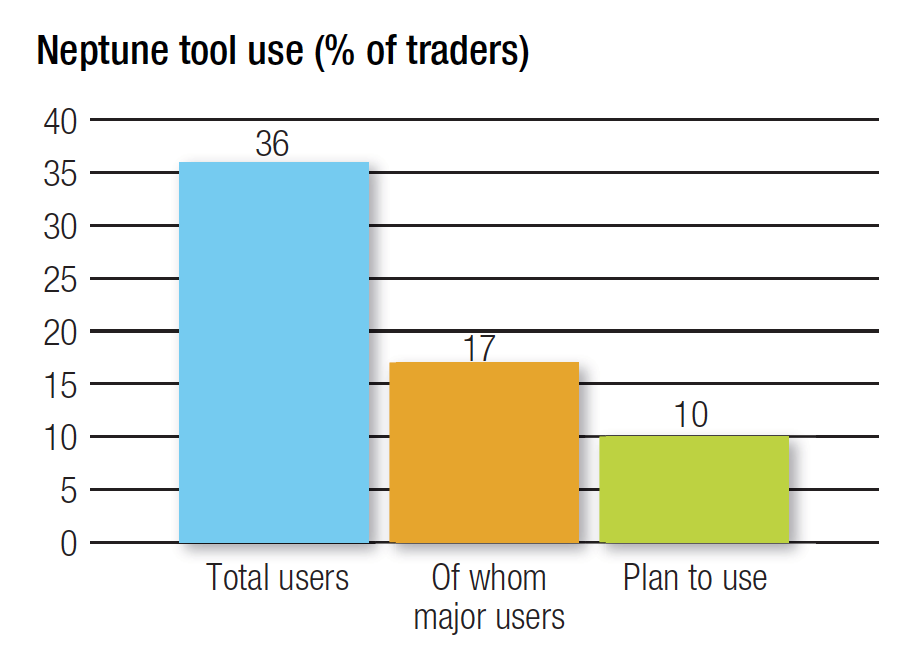 Neptune has expanded its user base to 36% of buy-side traders in 2021 up from 29% in 2020, a considerable increase and one that reflects its steady strategy.
Neptune has expanded its user base to 36% of buy-side traders in 2021 up from 29% in 2020, a considerable increase and one that reflects its steady strategy.
Over the last two and a half years the growth rate of clients coming from the US has been greater than in Europe, which is where the firm’s focus had initially been. Nevertheless, UK and continental Europe is still expanding says Byron Cooper-Fogarty, interim CEO at the firm.
“With John Robinson and Bob Burns joining in November 2020, both with excellent buy-side networks, and Ashley Armanno joining to expand our sell-side business we have good prospects for growth looking ahead notably in the US, with regional broker-dealers who are a target,” he explains. “Having boots on the ground to cement those relationships will give us a sure footing for continued growth. Neptune have also added staff in London, including Neelam Parikh, formerly at JP Morgan.”
As a delivery mechanism for axes and pricing, Neptune stands out as a data utility in the marketplace, one of the only success stories not tied to a trading venue. With dealers trying to deliver direct trading capabilities where possible, Neptune’s standardised data delivery model lets them engage with buy-side trading desks without the intermediation of a trading platform.
However, that has meant that Neptune has had to ensure its feed can be consumed by investment firms as easily as possible.
“Connectivity with order management system (OMS) and execution management system (EMS) vendors over the past 18-24 months has continued,” says Cooper-Fogarty. “Charles River was a major announcement for us last year and connectivity with buy-side investment tools remains a major priority.”
By concentrating on its core products and a strong delivery model, Neptune has seen a widening set of consumers realise the value of the information it offers, within existing clients as well as with the growing group of firms which are utilising it.
“People taking data through a direct application programming interface (API) now makes up a third of our clients and the trading teams getting the most out of our data are taking it in through multiple channels, including Charles River on the OMS side, and in the EMS space via Flextrade or TradingScreen,” he says.
Having made solid inroads on both sides of the Atlantic, the business is also looking at the best ways to reach the Asia Pacific region.
“We are keen to do more in Asia across both sides of the street; emerging markets as a product set is a big focus for us,” says Cooper-Fogarty. “We’re carrying significant amounts of liquidity but there are still gaps which remain and we’ve got a working group of buy-side firms identifying where those gaps are and how they can be addressed. That will help us to onboard the Asian subsidiaries of firms that are part of the network elsewhere.”
The importance of liquidity in investment decision-making in the fixed income markets is also leading to the widening interest in Neptune’s value across business lines.
“Portfolio managers are getting far more access to the data, and that allows them to make more intelligent decisions about which bonds to buy and sell,” he says. “We will continue to provide a link between axes and execution in a low cost environment that benefits buy- and sell-side clients.”
Streamed dealer prices
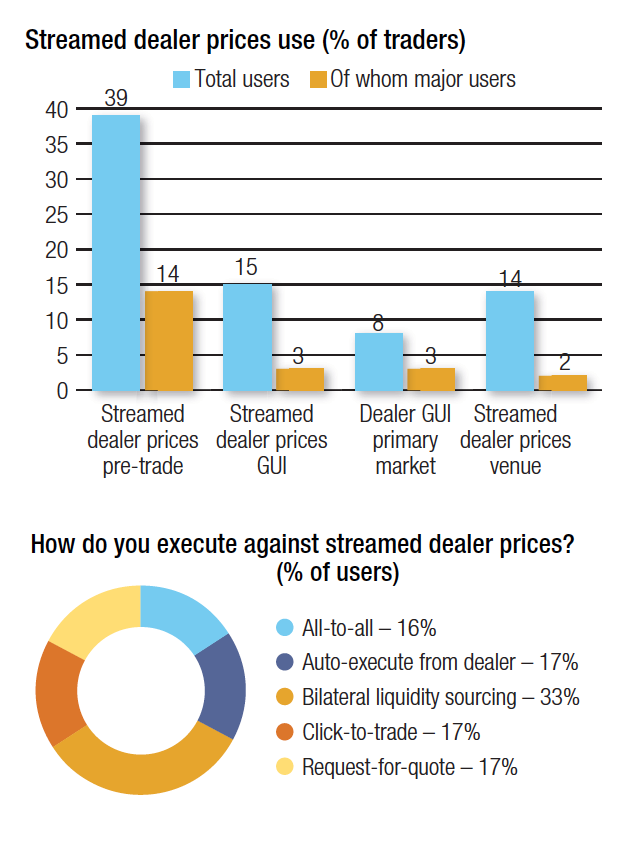 Direct e-trading connectivity with dealers in the credit market is on the rise. Over the past year, fixed income trading proved enormously profitable with the larger banks, and Coalition data estimates it delivered revenues of US$800 million+ in investment grade alone.
Direct e-trading connectivity with dealers in the credit market is on the rise. Over the past year, fixed income trading proved enormously profitable with the larger banks, and Coalition data estimates it delivered revenues of US$800 million+ in investment grade alone.
The challenge that banks face is an operational one. Scaling up the corporate bond trading business requires aggregation of liquidity and automation of process. That can happen through trading venues, but the banks push back on the fees they are charged, or it can happen on the trading desks via EMS/OMS connectivity which today is very limited.
The data bears this situation out, with streamed prices being well used as pre-trade data sources but dealers having less success in trading directly with clients, and with the use of direct GUIs for both primary and secondary markets still having relatively low levels of use compared with trading platforms.
Nevertheless engagement is growing, and if OMS/EMS vendors succeed in bringing the order routing to the trading desk – as they have done in equities – it may be that dealers can decrease intermediation from other platforms.
TP ICAP Group
 TP ICAP has walked right into the bun fight of dealer-to-client (D2C) corporate bond trading with several bold steps. The first has been the acquisition of block trading specialist Liquidnet. The connectivity that Liquidnet offers is significant, with 34% of traders accessing it for pre-trade data and 53% using its trading venue, up from 18% in 2014.
TP ICAP has walked right into the bun fight of dealer-to-client (D2C) corporate bond trading with several bold steps. The first has been the acquisition of block trading specialist Liquidnet. The connectivity that Liquidnet offers is significant, with 34% of traders accessing it for pre-trade data and 53% using its trading venue, up from 18% in 2014.
Liqudnet brings several advantages to the table. Firstly, its buy-side network complements TP ICAP’s dealer network. Its high proportion of all-to-all trading supports D2C trading as well as C2C trading and the focus on big blocks of bonds lends itself to trading across markets.
It has a primary market offering which 27% of traders plan to use, which is well supported by buy-side sentiment with the highest levels of confidence for continued use amongst primary market tools out to 2022 and 2025.
The TP ICAP group has also developed buy-side services which do not compete with its dealer clients including its TrueQuote business, whose Crosstrade service has a 10% penetration into the buy side and enables a midpoint price to facilitate and process internal crossing between funds or portfolios, and its Matchbook ReBalance designed to reduce residual risk in fixed income portfolios. In addition, TP ICAP’s data business has built a 10% user base amongst buy side traders for pre-trade services.
This collectively makes for an interesting combined business, however the firm’s leadership will need to deliver on the vision proposed by CEO Nicolas Breteau on 1 December 2020, to bring these services together in a way that delivers better pricing and liquidity formation to traders.
Tradeweb
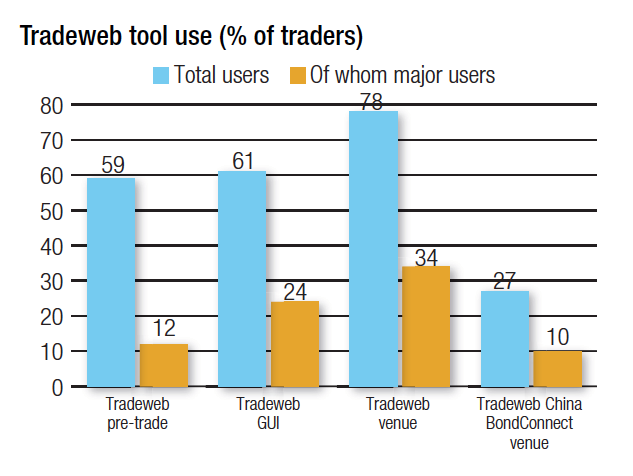 Tradeweb’s growth amongst users this year has been phenomenal, with double figure growth in users for its venue and its interface. The breadth of trading protocols it is offering is clearly paying dividends – portfolio trading uniquely turns up as a preference for trading on Tradeweb. Its automated trading tool AiEX and all-to-all trading offerings are both being used to good effect, while the firm has brought its government bond business to support both auto-spotting and auto-hedging.
Tradeweb’s growth amongst users this year has been phenomenal, with double figure growth in users for its venue and its interface. The breadth of trading protocols it is offering is clearly paying dividends – portfolio trading uniquely turns up as a preference for trading on Tradeweb. Its automated trading tool AiEX and all-to-all trading offerings are both being used to good effect, while the firm has brought its government bond business to support both auto-spotting and auto-hedging.
This has led not only to growth in use but in a more diverse way of engaging. In 2020 88% of traders were mainly engaging with Tradeweb primarily using request for quote (RFQ), with 6% preferring all-to-all trading and 3% using streamed prices. This year 12% prefer using all-to-all with 9% using streamed prices, and RFQ has fallen to 66% as the preferred protocol to use.
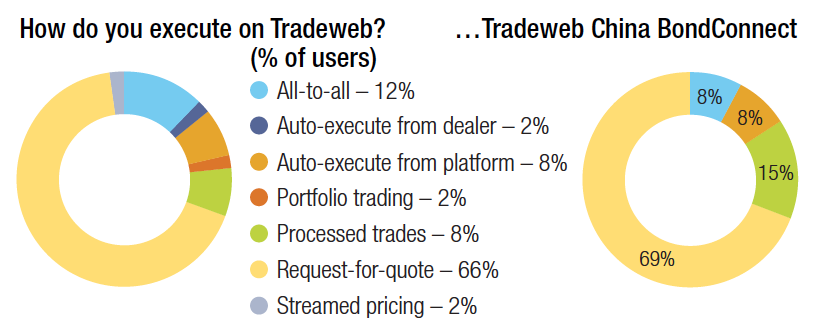
In the pre-trade data space Tradeweb has a pipeline of 12% of users planning to engage with it, the highest of any firm in that segment, suggesting its existing service is changing or improving.
Trumid
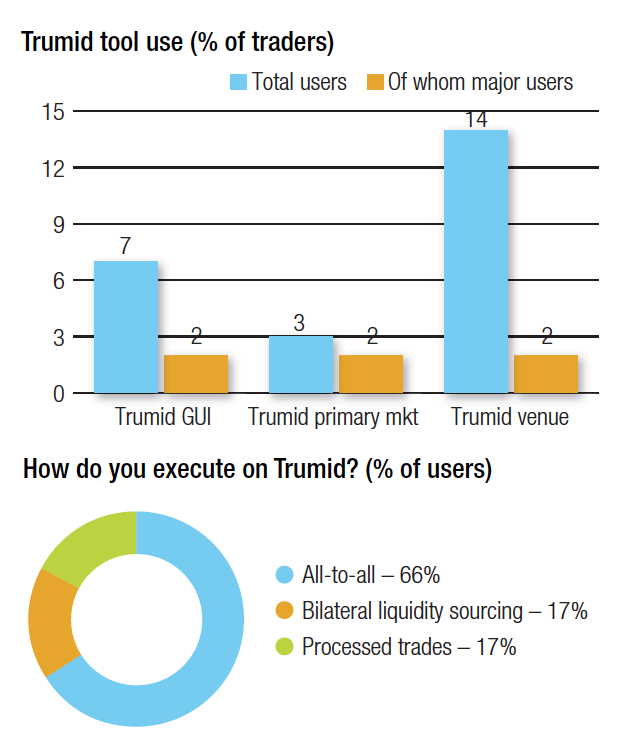 US-focused Trumid has seen steady growth since 2015 and now stands at 14% user base amongst the total group of buy-side traders, which would give it a 17% share when removing trading desks that do not trade US credit.
US-focused Trumid has seen steady growth since 2015 and now stands at 14% user base amongst the total group of buy-side traders, which would give it a 17% share when removing trading desks that do not trade US credit.
In October, the firm reported volumes were up 430% YoY, and it announced its expansion into EM markets, including a partnership with Singapore Exchange (SGX) and Hillhouse Capital to develop a joint venture, XinTru, to support bond trading in the APAC region.
In addition to secondary trading the firm has seen small success as a route to accessing primary markets.
UBS Bond Port
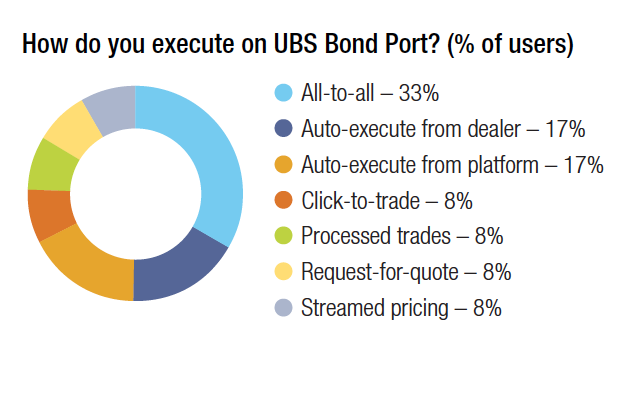 The one sell-side firm which has achieved success as a provider of aggregated electronic trading in credit space has been UBS with its Bond Port platform. It has consistently had a 25% market share for several years, and currently reports quoting around 35,000 unique CUSIPS across 19 currencies, while aggregating over 100,000 resting client orders a day for a total value of US$15 billion of executable liquidity.
The one sell-side firm which has achieved success as a provider of aggregated electronic trading in credit space has been UBS with its Bond Port platform. It has consistently had a 25% market share for several years, and currently reports quoting around 35,000 unique CUSIPS across 19 currencies, while aggregating over 100,000 resting client orders a day for a total value of US$15 billion of executable liquidity.
Greater activity over the past year saw volume and buy side engagement increase by over 150%, in Q2 with year-on-year volume for the first half of the year up by 111% in 2020, including buy-side participation up by 159%. The breadth of trading models that traders report using indicate it is winning this through innovation and flexibility.
©Markets Media Europe 2025






















